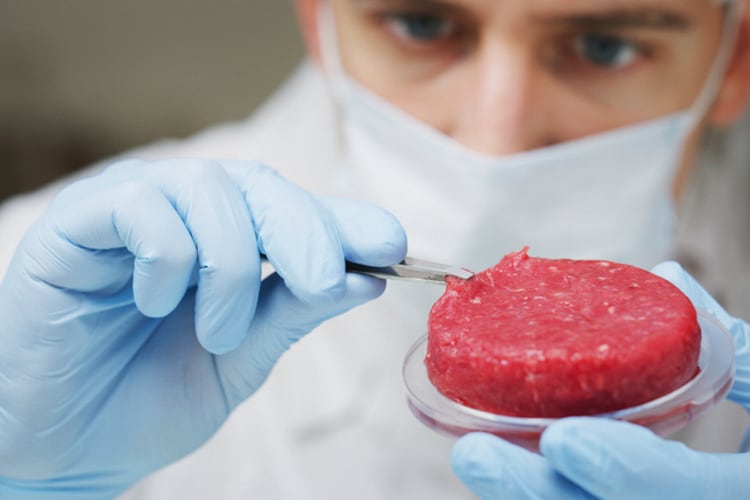Cellular agriculture and fermentation involve “building” food. Scientists and formulators use developments such as microbial growth and enzymatic processes to build individual food ingredients and entire products.
Technological advances are crucial to the application of cellular agriculture and fermentation, with systems focusing on enabling scalability to provide a sustainable offering. Alternative proteins, novel processing technologies and functional ingredients are examples of technologies that brands are deploying to create new foods that centre on the environment, functionality and the future of food.
Building food
Today, the process of building food involves three core methods. Traditional plant-based products are created using classic protein extraction, which sees the components form patties, or different forms, through an extrusion process. “While still the most common process for building plant-based alternatives, these products rely heavily on oilseeds and pulses like soy and pea proteins, but “new” ingredients like mung beans and blended products are emerging,” explained Caroline Keeley, Vice President of Partnerships at FoodBytes! by Rabobank.
Fermentation or precision fermentation-derived products include proteins developed using yeasts, bacteria, or fungi. The protein is made through the fermentation process on a carbohydrate-based medium. “This method is gaining in popularity as a way to create alternatives that solve issues of texture and taste that more traditional methods were unable to address,” Keeley noted. In particular, this method is applied to mimic the texture of meat when using plants.
Cellular agriculture is the growth of animal cells from stem cells in a laboratory, thus removing the animals from the animal protein supply chain. “While cellular agriculture is slowly getting to market, with alternatives like Finless Foods and Shiok Meats, it is still years away from achieving cost parity and scale due to the high cost of the process,” Keeley shared.
Regardless of the approach a manufacturer adopts, a formulator needs to consider a variety of factors when building food. Designing food people want and need, the cost of building food versus the cost of growing it, and developing new ingredients to achieve the desired taste and texture that consumers are used to must all be taken into account before embarking on a production process to build food items.
“No matter how you look at it, building food requires creativity and innovation to deliver the desired results while maintaining a ‘clean label’,” elaborated Anne Greven, Global Head of FoodBytes! by Rabobank.
Overcoming obstacles
Acknowledgement of the current struggles and challenges ahead for cell agriculture and fermentation manufacturers to scale is present. Elaborating on price concerns, Greven said the leading issue is that capital expenditure is high. As a result, companies will need to raise more money than other ingredient producers before being able to go to market, Greven highlighted.
“High costs remain a massive challenge for the industry and reaching price parity will be a key driver for growth for alternative proteins,” added Keeley. Today, Blue Horizon and BCG estimate the cost of goods sold for realistic plant-based alternative proteins remains approximately two times the cost of conventional animal proteins and sometimes even three times for precision fermentation, Keeley noted. Innovations ranging from better extraction technologies, larger-scale texturing processes, and optimising formulations for cell agriculture will, however, continue to drive prices down in the future.
Consumer acceptance of new food sources is still to be determined and continues to pose a hurdle for manufacturers in this space. As plant-based production inches towards price parity with animal protein production, consumers increasingly demand higher quality and a variety of alternatives. “In the past few years, we have seen a dramatic jump in quality proxy products such as butter alternatives that function just like the real thing and bloomy rind faux cheese,” says Keeley. “The number of fermented products has increased dramatically, with many being blended to achieve taste, texture and price expectations of consumers,” Keeley added.
The regulatory landscape is also a key obstacle facing those in the cell agriculture and fermentation sphere. “While some progress has been made, broader regulatory approval has yet to be seen—many established corporates will only work with GRAS-certified products, which can take years to achieve,” Keeley highlighted.
For cell agriculture, specifically, there are more challenges, Greven shared, namely proprietary cell lines, high raw material costs, animal source nutrients, and limited manufacturing scale. “While a great deal has advanced to bring the cost down, it is still far away from being a viable solution,” noted Greven.
Achieving a breakthrough
Despite significant obstacles, the overall perception of the potential of cell agriculture and fermentation is one of hopeful promise. “The belief across the board is that these new methods of production will help relieve many of the stressors on the planet, reducing the drain on natural resources,” said Greven.
“At the same time, while these methods are believed by many to be more sustainable, they take time and come at a high cost, which is likely some of the reasons the path to market has been slow,” Greven added.
Rabobank states it is seeing more growth in the category each year via its FoodBytes! platform, which is designed to enable networking and connection in the food, agribusiness and technological space.
Celf Nutrition is a FoodBytes! alumni fermenting upcycled carbon, or renewable methanol, into a whole food protein-rich in antioxidants and butyrate. The process and product have been tipped as ideal for accelerating the adoption of mass-market blended beef and pork that are price accessible and indistinguishable in taste, texture, smell, and colour.
Food technology company Resugar uses fermentation to replicate the taste and properties of sugar while eliminating harmful effects. It strives to deliver the essence of sugar with none of its drawbacks.
Focusing on food colours, Phytolon uses fermentation to offer natural colours uniquely positioned to comply with consumers’ need for healthy and sustainable food and the industry’s requirements for cost efficiency and high quality.
Ergo Bioscience is another alumni in the area of replication. The Argentinian biotech startup has a fermentation platform that replicates myoglobin and casein from plant cells to enable the production of better-performing plant-based proteins.
Pursuing scalability and sustainability
The potential of cell agriculture and fermentation to progress the sustainability of the food industry is “significant”, Keeley said. The projected market for alternative protein stands at $290 billion (€290.8 bn) in 2035, according to a Boston Consulting Group and Blue Horizon 2021 report, which represents about 10% of the overall protein market.
Environmental, social, and corporate governance (ESG) and sustainability movements are also driven by the growing consumer group of flexitarians, which some estimates put at 30% of US consumers, Keeley noted.
Cell agriculture and fermentation methods can also mitigate the use of finite resources, including water and soil, and reduce the carbon footprint of food, depending on how it is measured, Greven says. Fermentation reactions can also increase the nutritional availability of food, leading to, for example, higher protein stains of crops, thereby increasing access to affordable nutrition. “With fermentation, removing the animal altogether removes the moral challenges that many face with eating animal-derived products,” said Greven.
“Alternative proteins, therefore, check multiple boxes: sustainable, better-for-you, and for the planet while offering nutritional benefits comparable to their animal protein counterparts,” Greven concluded.




